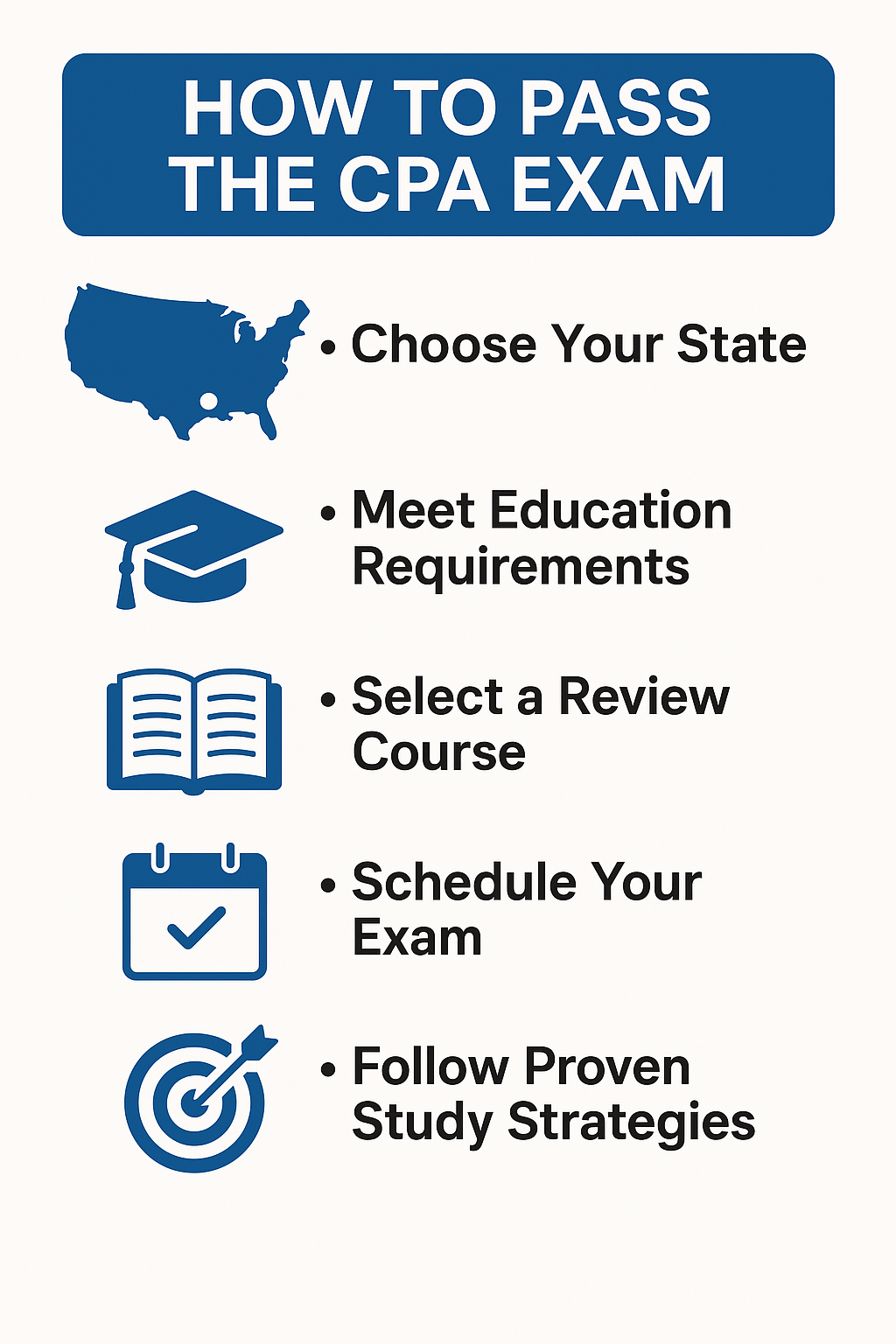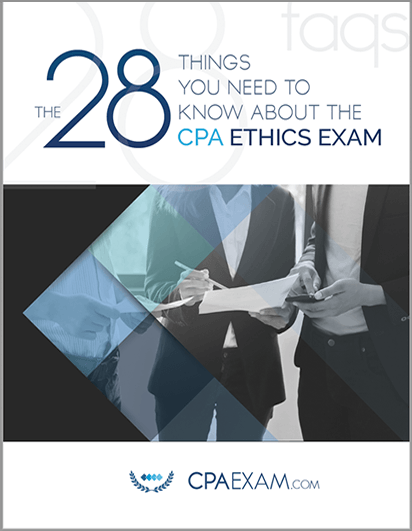How To Pass the CPA Exam: From Start to Finish
Passing the CPA exam can be a long and confusing process.
Not only do the guidelines and protocols for the exam vary from state to state, but you also have to learn material that is notoriously difficult to understand.
This means that the path towards becoming a certified public accountant varies from person to person. It depends on several things, such as:
- What state you test in
- Your existing professional and educational background
- How much time you have to allocate towards studying
If you’re feeling overwhelmed by your own journey towards becoming a CPA, don’t worry. We’ve put together a proven framework to help you get your CPA license, from start to finish.

In this article, we’ll discuss:
Table of Contents
Choose Your State
The requirements for qualifying to sit for the CPA exam vary, so you’ll want to keep that in mind when choosing what state to take your exam in. Most states require CPA candidates to have at least 120 credit hours before taking the CPA exam, which can take several months.
However, there are certain provisionary states where candidates can take the exam before completing all of their education requirements. This means that you can sit for the exam as long as you complete your educational requirements within a certain timeframe, which is dependent on the state.
Even though you sit for the exam though, you won’t be able to receive your test scores until you fulfill all of your educational requirements.
Review Your Education Requirements
Educational requirements vary depending on what state candidates take their test in. This can range from different study material to whether or not you’re a resident of the state you’re testing in.
However, there are two requirements that stay the same no matter what state you’re testing in:
- Candidates must pass all four sections of the exam with a minimum score of 75.
- Candidates must pass all four sections within 18 months.
Once those two requirements are fulfilled, it’s up to you to review your state board’s official website and learn about what else is needed to fulfill any specific requirements.
Apply and Pay Your Application Fees
Once you’ve met your educational requirements, your next step is to submit a CPA Exam application to your state board of accountancy, often processed through the National Association of State Boards of Accountancy (NASBA) for most jurisdictions.
Common application requirements include:
- Application fee
- Proof of identity (e.g., driver’s license or passport)
- Official transcripts or education documentation
The application fee varies by state but typically ranges from $50 to $200. This is a one-time fee paid when you first apply to take the CPA Exam.
⚠️ Note: You may incur additional fees if:
- Your application is incomplete or rejected and needs resubmission.
- Your Notice to Schedule (NTS) expires before you take your exam.
Choose Your Exam Section
Under the CPA Evolution model, the CPA Exam now consists of three Core sections and one Discipline section of your choice.
Core Sections (required for all candidates):
- Auditing and Attestation (AUD)
- Financial Accounting and Reporting (FAR)
- Taxation and Regulation (REG)
Discipline Sections (choose one):
- Business Analysis and Reporting (BAR)
- Information Systems and Controls (ISC)
- Tax Compliance and Planning (TCP)
You can take the four sections in any order, and your decision should be based on your strengths, background, and test-taking strategy. Some candidates start with their strongest subject to build momentum, while others prefer to get the most challenging section out of the way first. If your academic or professional experience aligns with a particular Discipline, it might make sense to take that one early.
There’s no universally “correct” order — choose the sequence that fits your study plan and confidence level.
Choose Your Review Course
When it comes to choosing a review course, it’s important to pick a course that gives you several different ways to study. By consuming written, audio, and video material, you can give yourself the best shot at retaining and understanding the material you’ll encounter on the CPA exam.
When it comes to multi-media review courses, we recommend Ninja CPA Review. They’re full roster of study material includes:
- MCQ Testbank
- Books
- Notes
- Audio
- Live & Recorded Tutoring
An additional plus is that you can pay it on a monthly basis, reducing the typical high costs associated with most standard CPA review courses.
We have a free on demand training ‘How To Choose The Right CPA Review Course For You’ that you can use to find the right fit.
Select Your Exam Date
The CPA exam is offered four times each year:
- January 1 – March 10
- April 1 – June 10
- July 1 – September 10
- October 1 – December 10
You can visit the Prometric website to schedule your exam and choose a testing location that’s convenient to you. You’ll also need to provide testing documentation to upload to Prometric.
Paying CPA Exam Fees
Once you receive your Notice to Schedule (NTS), you’ll need to pay two types of fees before sitting for the CPA Exam: exam section fees and registration fees.
Exam Section Fees
The cost to take each section of the CPA Exam is $193.45. Since the exam has four sections, you’ll pay this fee each time you schedule one.
Registration Fees
In addition to the per-section cost, most jurisdictions charge a registration fee based on the number of sections you sign up for at one time. These fees follow a tiered structure:
- 1 section: $63
- 2 sections: $81
- 3 sections: $99
- 4 sections: $177
Registering for multiple sections at once can reduce your overall fees—but be careful. Your NTS is typically valid for only six months, so you must sit for all registered sections within that timeframe.
🔍 Note: Fee structures and policies may vary slightly depending on your state board of accountancy. Always confirm exact costs with your state’s licensing authority.
Study Using A Framework
When you’re ready to start studying, it’s important to study using a proven framework. Here’s a simple 4 part process that will help you get the most out of your study time:
- Master the basics: In order to master the CPA testing material, you’ll need to have a solid foundation to build on. Before you begin studying for the exam material, make sure you have a comprehensive understanding of accounting concepts.
- Write notes: It’s been proven that note-taking helps students retain information more easily, so take notes on all of your study material.
- Review your multiple choice questions (MCQs): Drilling through your review course’s MCQs is a great way to notice what material you know well and what you may need to work on.
- Rewrite your notes: When it comes to studying for the CPA exam, a lot of it will come down to studying repetitively. Rewriting your notes will help solidify the information even further in your mind.
Once again, we have a free on demand training ‘How To Choose The Right CPA Review Course For You’ that you can use to find the right fit.
Passing The CPA Exam
Now, you’re ready to pass your CPA exam! Keep these key notes in mind when going through your CPA application process:
- Each state has different qualifications to sit for the CPA exam, so make sure to check what requirements you’ll need with your state board.
- No matter what state you test in, you must pass your exams with a score of 75 within 18 months of each other from start to finish.
- Your study style will be dictated by your own personal strengths and weaknesses.
- Repetitive study is the best way to pass the exam in the shortest amount of time, so don’t skimp on your study sessions.
Ready to study for the CPA exam? Check out our study guide here.
